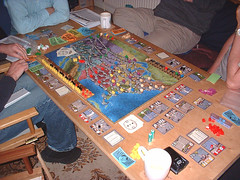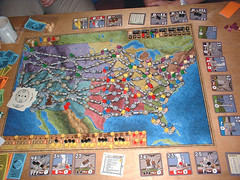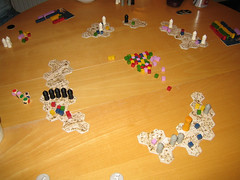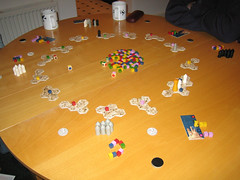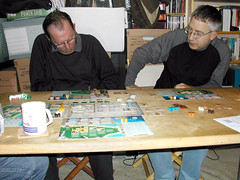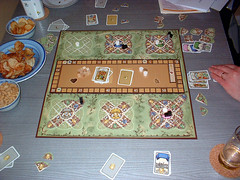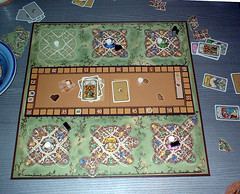No Billygames again last night, so I did’nt have to tape CSI and CSI Miami. I think that they have made them a bit too gory now, and I definitely don’t like the way they have split up the team and given Grissom a minor role now. Catherine is sucking up to the new boss, ugh!. Anyway the theme music is still great (the Who) So what has this to do with boardgames, well, nothing really.
But this Saturday we have a full days gaming to look forward to. Garry is kindly hosting, and Steve, Richard and myself will make four players. This enables us to play the slew of 4 player games that we normally don’t have a chance to play because we are normally more than four. I will take over a couple of my favourites, probably Goa and St. Petersburg. I think they will have strong competition for table time because Garry has just received a big parcel of games from Adam Spielt. I know he has Oltremare and China for a start. Oltremare has had some good reviews and I am looking forward to playing it. More of a card game than a boardgame, but hey, I like cardgames too. So you can be sure that I will have a full report with pictures of the days events, until then happy boardgaming!
Wednesday, April 27, 2005
Wednesday, April 20, 2005
Powergrid - Mid game board position
This picture shows the board position somewhere in the middle of the game. The turn order marker is top left on the board, the city marker top right and the resources are bottom left. Player colours are, Neil natural wood, Garry green, Steve blue, Richard purple, Natalie red and myself yellow.
Tuesday April 19th - Powergrid
Our first play of Power Grid was way back in February, and that was with four players. I must admit we struggled a bit with the rules then. The first turn took us nearly an hour! After that the game did speed up, but we didn’t finish it. This time we was a full complement of 6 players and we finished the game in about 150 minutes. This time we played the American board. The blue region bottom left in the picture was the no-go area for this game. We all managed to claim a reasonable position to start building from except maybe Garry, who was stuck in the north west area. Neil pretty much cornered the east coast, Natalie, Steve and myself starting centrally and worked our out way from there. This game requires a bit of mental arithmetic, working out your building costs and resources needed against your power plant expenditure and income. The manipulation of the turn order can important as the player with the most cities goes first in the auction for power plants, this was Neil pretty much all game. And the last player goes first buying resources and building cities. Obviously this can be quite important and I think Richard did try to buy power plants with numbers that would give him an advantage in turn order. Once you get into the swing of this game it does flow quite smoothly and I really like it. The winning condition is not only having the most cities but having the resources to power them as well, in the event of a tie most money in hand is the tiebreaker. At game end it was very close.
Final Scores (Cities supplied/Money in hand)
Neil 15, Richard 14/24, Colin 14/28, Steve 13/35, Garry 13/16, Natalie 11
Final Scores (Cities supplied/Money in hand)
Neil 15, Richard 14/24, Colin 14/28, Steve 13/35, Garry 13/16, Natalie 11
Monday, April 18, 2005
Carolus Magnus-End Position
This is a picture of the board at the end of the game. I am black, Garry is grey and Steve white. After we finished Steve suggested a game of Zendo. A bit of a deduction game, not really my cup of tea, but that is another story.
April 15th - Carolus Magnus At Garry’s
So Garry said, I have a free night on Friday, the wife’s having a girls night, anyone up for a game, well Steve and I were takers and the game we ended up playing was Carolus Magnus. This 2000 game by Leo Colovini is an excellent 3 player game. Here is a brief desciption from BGG.
This game uses a collection of smallish hexagon clusters arranged in a circle. Mercenaries, in the form of small wooden blocks, are placed onto the land pieces. Players can then use these blocks to attempt to gain control of the corresponding mercenary type, or place the same small blocks onto the board which can help the player who controls that color. Once a player has majority of control markers on a piece of land, he can build a tower there. The tower serves as a semi-permanent control marker, as well as a way to win. If two land pieces are controlled by the same player, the land pieces are combined into one, which makes the position harder to take by the other players. The first player to place a set number of towers wins the game, but the game can also end when the land masses are reduced to three or fewer, in which case the player with the most towers placed wins.
When Steve ran through the rules, Garry and I had not played before, it all seemed a bit confusing, I think Garry agrees with that. But like a lot of games after youv’e played a round it all starts to become clear. The majority of cubes get placed onto your court, to control the colours on the board. And only a few, well in this game anyway, get placed on the board to increase holdings in that colour. You have to be careful, because you could place a lot of cubes on the board only to lose control of the colour giving your opponent a strong position. The game proceeded smoothly, with control of the provinces swapping to and fro. The discs that you play to determine turn order and the number of moves the king makes is a really interesting mechanic and deserves thoughtful play.
I managed to get down to 2 castles left to play and a 2 disc left in hand. Whatever Garry or Steve did I could get to a province that I could control both needing majority in blue which I held. So I managed the win, an excellent game that I would willingly play again.
Final Score
Colin 8 Castles Garry 4, Steve 3
This game uses a collection of smallish hexagon clusters arranged in a circle. Mercenaries, in the form of small wooden blocks, are placed onto the land pieces. Players can then use these blocks to attempt to gain control of the corresponding mercenary type, or place the same small blocks onto the board which can help the player who controls that color. Once a player has majority of control markers on a piece of land, he can build a tower there. The tower serves as a semi-permanent control marker, as well as a way to win. If two land pieces are controlled by the same player, the land pieces are combined into one, which makes the position harder to take by the other players. The first player to place a set number of towers wins the game, but the game can also end when the land masses are reduced to three or fewer, in which case the player with the most towers placed wins.
When Steve ran through the rules, Garry and I had not played before, it all seemed a bit confusing, I think Garry agrees with that. But like a lot of games after youv’e played a round it all starts to become clear. The majority of cubes get placed onto your court, to control the colours on the board. And only a few, well in this game anyway, get placed on the board to increase holdings in that colour. You have to be careful, because you could place a lot of cubes on the board only to lose control of the colour giving your opponent a strong position. The game proceeded smoothly, with control of the provinces swapping to and fro. The discs that you play to determine turn order and the number of moves the king makes is a really interesting mechanic and deserves thoughtful play.
I managed to get down to 2 castles left to play and a 2 disc left in hand. Whatever Garry or Steve did I could get to a province that I could control both needing majority in blue which I held. So I managed the win, an excellent game that I would willingly play again.
Final Score
Colin 8 Castles Garry 4, Steve 3
Wednesday, April 13, 2005
Tuesday 13th - Puerto Rico + Expansion/Boomtown
Well, it was going to be Power Grid with 6 or Puerto Rico with 5. In the end it was Puerto Rico with 4! So, Puerto Rico plus expansion, Steve and I had played this version before, but Neil and Garry had not. I should imagine most people have played the classic version of Puerto Rico so this is a quick resume of what the expansion adds.
The expansion adds the forests and the following new buildings to the game: Aqueduct, Forest House, Black Market, Storehouse, Guesthouse, Church, Trading Post, Small Wharf, Lighthouse, Library, Speciality Factory, Union Hall, Cloister, and Statue.
Before the game starts proper there is a set up phase where players choose which buildings populate the board, so you get a mixture of old and new, this choice can be interesting. So you could end up with no markets or warehouses for example. This obviously affects the strategy you will employ during the course of the game. Usually certain players have a favourite strategy and you can take an educated guess as to what way they’re going to go, but with the expansion thrown into the mix it stirs things up a bit.
I managed to get some coffee plantations and a roaster, but made the mistake of not manning the roaster as soon as I could. This led to a pinch on the money for me early on. After the game Steve explained why he goes for sugar, people, he said go for indigo and corn because that’s what you get to start and it’s cheap, then they go for the tobacco and coffee for the big bucks they generate. That leaves sugar in the middle, which is relatively cheap and can be traded for 2. Money is the key early on, get as much as you can. This Steve certainly accomplished, he had wads, and the lighthouse paid off big time for him. Consequently the game finished really quickly, in just over an hour, certainly too quick for me to build a decent score.
I like the expansion, it adds a new twist to the game and makes you think just a bit more.
Final Scores
Steve 53, Colin 33, Neil 30, Garry 27
As that finished so quickly Steve suggested that we give Boomtown a run out. This is a brief description from BGG.
In Boomtown, you start as a gold digger and try to end as a tycoon.
To do this, you must first buy the best mining concessions, hoping to find gold veins. You can also try to become the Mayor of Whiskey River or San Narciso, in order to get a small cut on concessions sales, or build a saloon where lucky prospectors will spend their nuggets in moonshine whisky. If business is really bad, you can still rely on bank or stagecoach hold-ups to reestablish you. A well placed stick of dynamite can also solve some minor problems.
Steve quickly ran through the rules and off we went, I f ound this game quite entertaining. A bit to think about, when to bid, what to bid, and if you win the auction which card to take or leave. We soon rattled through the deck and Steve’s previous plays showed through as he took an easy win.
Final Scores
Steve 141, Colin 85, Neil 79, Garry 65
The expansion adds the forests and the following new buildings to the game: Aqueduct, Forest House, Black Market, Storehouse, Guesthouse, Church, Trading Post, Small Wharf, Lighthouse, Library, Speciality Factory, Union Hall, Cloister, and Statue.
Before the game starts proper there is a set up phase where players choose which buildings populate the board, so you get a mixture of old and new, this choice can be interesting. So you could end up with no markets or warehouses for example. This obviously affects the strategy you will employ during the course of the game. Usually certain players have a favourite strategy and you can take an educated guess as to what way they’re going to go, but with the expansion thrown into the mix it stirs things up a bit.
I managed to get some coffee plantations and a roaster, but made the mistake of not manning the roaster as soon as I could. This led to a pinch on the money for me early on. After the game Steve explained why he goes for sugar, people, he said go for indigo and corn because that’s what you get to start and it’s cheap, then they go for the tobacco and coffee for the big bucks they generate. That leaves sugar in the middle, which is relatively cheap and can be traded for 2. Money is the key early on, get as much as you can. This Steve certainly accomplished, he had wads, and the lighthouse paid off big time for him. Consequently the game finished really quickly, in just over an hour, certainly too quick for me to build a decent score.
I like the expansion, it adds a new twist to the game and makes you think just a bit more.
Final Scores
Steve 53, Colin 33, Neil 30, Garry 27
As that finished so quickly Steve suggested that we give Boomtown a run out. This is a brief description from BGG.
In Boomtown, you start as a gold digger and try to end as a tycoon.
To do this, you must first buy the best mining concessions, hoping to find gold veins. You can also try to become the Mayor of Whiskey River or San Narciso, in order to get a small cut on concessions sales, or build a saloon where lucky prospectors will spend their nuggets in moonshine whisky. If business is really bad, you can still rely on bank or stagecoach hold-ups to reestablish you. A well placed stick of dynamite can also solve some minor problems.
Steve quickly ran through the rules and off we went, I f ound this game quite entertaining. A bit to think about, when to bid, what to bid, and if you win the auction which card to take or leave. We soon rattled through the deck and Steve’s previous plays showed through as he took an easy win.
Final Scores
Steve 141, Colin 85, Neil 79, Garry 65
Wednesday, April 6, 2005
Tuesday 5th April - Flandern 1302
Billygames bursts back into life after a couple of weeks inactivity. Due to a combination of circumstances we were only 3 to try Flandern 1302 a reletivily new game from Wolfgang Panning. Here as usual is a brief description from BGG.
This game is about the struggle for power and influence in cities by the competing guilds of the age. Players represent one city colour & have a set of tiles in 3 shapes in your colour and a set of cards for each city plus 4 action cards. You play a card and place a tile either from your set or from the church or neutral sets. The starting player also first draws a card from a central deck which effectively gives them an extra move. Tiles of the same colour cannot touch and the church tiles allow cities to expand.
When a city is completed, it is scored. The colour with the most tiles gets the 1st score, the second colour gets half that, the next gets 4 points and the fourth colour gets 2 pts. Therefore it is possible for the nuetral colour to score more points than players. The score is a total of the tiles in the city, plus one for each church, plus one for each cathedral place.
As nobody had played this before it took us a while to read through the rules, but it soon fell into place. I must say that I am quite partial to tile laying games. Renier Knizia has a few that I like a lot, Samurai, Tigris & Euphrates to name a couple. After we had played the first couple of turns it started to fall into place. Playing the card that allows you to take all your cards back into hand can be very useful if played at the right time. And you only have 3 influence cards in your starting hand, it pays to use these wisely as well. You can get more influence cards from the deck of gold cards, but you can’t rely on getting them. Using the church and neutral (grey) tiles can be critical too. Either to increase the points score of a city that you are confident of winning or denying space for an opponent to get one of their tiles into the city. In fact the grey guild did fairly well in our game, beating Steve to third place!
I enjoyed our first playing of Flandern 1302, and would certainly play again. The picture is just over half way through the game with two cities left to score.
This game is about the struggle for power and influence in cities by the competing guilds of the age. Players represent one city colour & have a set of tiles in 3 shapes in your colour and a set of cards for each city plus 4 action cards. You play a card and place a tile either from your set or from the church or neutral sets. The starting player also first draws a card from a central deck which effectively gives them an extra move. Tiles of the same colour cannot touch and the church tiles allow cities to expand.
When a city is completed, it is scored. The colour with the most tiles gets the 1st score, the second colour gets half that, the next gets 4 points and the fourth colour gets 2 pts. Therefore it is possible for the nuetral colour to score more points than players. The score is a total of the tiles in the city, plus one for each church, plus one for each cathedral place.
As nobody had played this before it took us a while to read through the rules, but it soon fell into place. I must say that I am quite partial to tile laying games. Renier Knizia has a few that I like a lot, Samurai, Tigris & Euphrates to name a couple. After we had played the first couple of turns it started to fall into place. Playing the card that allows you to take all your cards back into hand can be very useful if played at the right time. And you only have 3 influence cards in your starting hand, it pays to use these wisely as well. You can get more influence cards from the deck of gold cards, but you can’t rely on getting them. Using the church and neutral (grey) tiles can be critical too. Either to increase the points score of a city that you are confident of winning or denying space for an opponent to get one of their tiles into the city. In fact the grey guild did fairly well in our game, beating Steve to third place!
I enjoyed our first playing of Flandern 1302, and would certainly play again. The picture is just over half way through the game with two cities left to score.
Flandern 1302 Final
So this is the board at the end. The centre city at the bottom of the board has just been scored. Does it pay to try and get a presence in all cities or concentrate on one or two? You only have a limited number of action cards to play, when do you play the card to get them all back? Do you use one of your provinces or choose a church or neutral piece? You only have a limited number of your own pieces and they soon run out. All this gives you multiple choices and not enough actions to carry it all out. I think this is always a good sign in a game. You always want to do more. As I say I liked it, the fact that I won in no way coloured my opinion :)
Final Scores
Garry 37, Steve 27, Colin 47, Grey (neutral guild) 28
Final Scores
Garry 37, Steve 27, Colin 47, Grey (neutral guild) 28
Subscribe to:
Posts (Atom)
